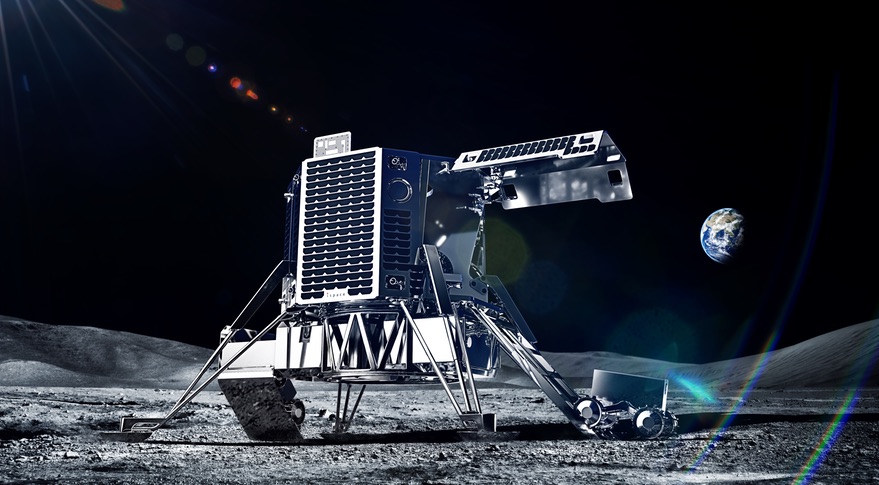Actually, this is a free translation of
this article .

A landing module and a “micro” rover that Ispace is developing for lunar missions. During the first round of financing, which ended on December 13, the company received more than $ 90M. According to Ispace calculations, this should be enough for two demonstration missions until the end of 2020. Authors: Ispace
NEW ORLEANS, a Japanese company planning a series of robotic missions to the moon, announced on December 13th that it had raised over $ 90 million in its first round of funding, which became one of the largest rounds of series A for any newly emerging space enterprise.
Tokyo Ispace announced the completion of the first round of financing in which it received $ 90.2M. The funds were received from a consortium of Japanese foundations and companies, and will be used to develop two missions from launch to late 2020 as part of the preparation of a series of regular missions with a soft landing on the moon in subsequent years.

In an interview with Takeshi Hakamada, the founder and CEO of Ispace, he said that he planned to receive such a large amount so that he had enough money to carry out these demonstration missions.
“We wanted to make sure our funding was enough for two test missions.” He said. “With these two missions, we are going to test our technology, and make a successful soft landing on the moon.” After we confirm the technology, we are going to become a lunar transport company. ”
Ispace has planned two missions, including using the lander, which the company is currently creating. The first mission is planned in the fourth quarter of 2019, and should place a satellite in near-moon orbit, in order to observe the lunar surface. The second mission, which is scheduled to launch by the end of 2020, will attempt to make a soft landing and deliver a whole range of small all-terrain vehicles to the moon.
Work on the orbiter began at the beginning of this year, Khakamada said. The descent vehicle must go through two key development stages, a preliminary analysis of the project and a subsequent critical review of the design in the coming year. According to him, the company is negotiating to launch the spacecraft as secondary payloads on vehicles such as SpaceX Falcon 9.
If the missions are successful, Hakamada said, Ispace plans to offer the next series of landing missions to deliver up to 30 kg of customer payload to the surface of the moon. “We intend to create a transportation company for the delivery of goods to the moon,” he said. “One of the key points of the concept is regular, systematic delivery of cargo to the moon.” Such missions, he added, depending on demand, can fly at least monthly.
Khakamada says revenues from these missions may be sufficient to allow the company to abandon additional rounds of funding. “If we can successfully demonstrate our technology through these two first missions, we don’t need to attract additional funding,” he said.
These missions will not be the first spacecraft that Ispace sends to the moon. The company, through
Team Hakuto , is a
Google Lunar X Prize finalist. The team built a rover, which plans to send to the moon using the apparatus developed by another finalist,
Team Indus .
The team built the rover and completes testing it before sending it to Team Indus later this month. It is unclear, however, when the Team Indus will be ready to launch. This team recently said it seeks to raise $ 35 million, half the total cost of the mission through sponsorship and crowdfunding. This effort comes just a few months before the start of the competition expires at the end of March 2018.
Khakamada said both teams are still working to launch the mission before the prize date, but declined to give a launch date.
Several funds and companies in this round of financing. Khakamada said that he could not disclose the amounts that each participant of the tour contributed, but said that the Innovation Network, the Japanese corporation, contributed $ 31 million to this round.
Other Series A members include Development Bank of Japan, Tokyo Broadcasting System, Konica Minolta, Shimizu, Suzuki Motor, SPARX, Dentsu, Real Tech Fund, KDDI, Japan Airlines and Toppan Printing. In addition to financing, Khakamada said investors will provide Ispace technology and other support.
According to the company, $ 90.2M was the largest amount of initial funding in the “global commercial space industry” to date. However, it is known that OneWeb, a company developing a low-orbit satellite constellation, raised $ 500M to what it calls the round of A-series financing, completed in 2015.
In addition to its headquarters in Tokyo, Ispace also has offices in the United States and Luxembourg, responsible for business development in North America and Europe, respectively. The company has signed a memorandum of understanding with SpaceResources.lu, a structure created by the Government of Luxembourg to support the creation of the space resources industry, and also collaborates with a research company whose mass spectrometer plans to use in its missions.
In its announcement, Ispace stated that it ultimately wanted to maintain a constant human presence on the moon. The company believes that on the moon by 2040 in the various industries will work about 1000 people. The company, said Khakamada, "will lead this development by providing access to the lunar surface and creating a world in which the Earth and the Moon will be a single ecosystem."
ZY
Thanks to the respected
pnetmon , the company's website was discovered, and there is a very interesting video on the company's plans, which I have already posted in the comments, but decided to put it here:
By the way, there is a second video about the team working on the project: